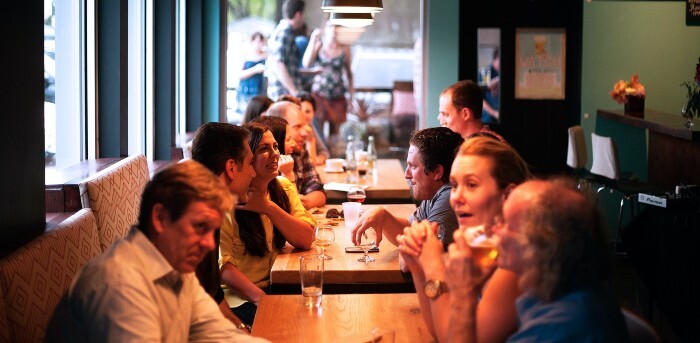15 Food Marketing Tricks They've Been Duping Us With

You’d think, since we need it to survive and all, food would be the thing that needs the least marketing in the world, maybe aside from boobs and jet skis. But food companies want us eating only the sweetest, saltiest, most addictive food they can wrench from the depths of their nightmares, so they’ve created entire industries and fields of science to keep you mindlessly chewing the corporate cud.
Scent

While most bakeries do their kneading and seeding in the hours that shouldn’t exist to make sure their goodies are fresh every morning, Panera bread does the opposite to make sure the store smells like fresh bread when you walk in. Cinnabon also places their ovens near the front of their stores to lure you away from smelling all the candles at Bath & Body Works.
Colors

Have you ever noticed that all fast food restaurants have roughly the same color schemes? It’s a lot of red and yellow, because yellow is a “happy” color but red is the color of alarms and stop signs and other things that lend a sense of urgency. Basically, they want you desperate to be happy.
Meaningless Buzzwords

The only legal requirement for calling a food “fresh” is that it’s never been frozen; it doesn’t mean it won’t have the texture of a limp diaper. Likewise, you are almost never eating Kobe beef, and the term “cage free” is an impressive exercise in semantics.
Tricks to Make Food Look Good in Pictures
All kinds of things are substituted, like glue for milk or mashed potatoes for ice cream, or added, like Scotchgard on pancakes or soap in carbonated beverages, to food to make it look better on film. It might look tasty, but you’d be in a world of regret if you actually took a bite.
Intentionally Confusing Menus

Have you ever found yourself at a fast food counter, panicking in the face of jumbled mess of burgers and nuggets, trying to identify the item you want before it winks out of existence? That’s by design, to pressure you into just picking a random item (usually the one with the nice big picture) instead of making a careful decision. Fancier restaurants do this, too, with nonsense French-ish words that shame you into ordering stuff even if you have no idea what it is.
Menu Animation
Companies like McDonald’s even use animation specifically to direct your eyes away from the cheaper items, which is how you end up ordering a $12 burger when you walked in singing a song about nuggies.
Menu Psychology

Menu psychology is a whole field of study that holds the secrets to getting you to order what best suits the restaurants, not your tum. For example, people naturally look at the center of a menu first, then the top right, then the top left, so try to head straight to the bottom. That’s where they keep the cheap stuff.
The Health Halo

If you’ve noticed that fast food menus tend to feature big photos of salad front and center, it’s not (just) because the markup on those is so high. It also makes everything else on the menu seem healthy by association. It’s also why grocery stores put their produce sections at the front and packaged food companies are vying to get their products placed there.
Misters

Grocery stores mostly let their produce run through the sprinklers for two reasons: so it’ll look better and weigh more. Some fruits and vegetables actually degrade faster under too much moisture.
Saline Meat
Plants aren’t the only things in the grocery store that get an aquatic fluffer. Lots of meat manufacturers inject their products with saline to make them look juicier and weight more.
Decoy Pricing
You know how every fast food restaurant offers a large soda for five cents more than a medium? That’s called decoy pricing, and it gets you to spend more by offering you a product just to make the expensive version look better by comparison.
Seating

Depending on how quickly they want you to leave, restaurants adjust the comfort of their seats accordingly, which is why all fast food seats are twisted hunks of plastic determined to make your butt the star of its own Hostel film.
Lighting

That’s the same reason fast food restaurants all live in a fluorescent hellscape. On the other hand, fancy restaurants keep the lights low so you have to lean in to read the menu, which encourages intimacy with your foodmates and keeps you talking and ordering outrageously marked up wine.
Music
Restaurants can also encourage you to stay or go by adjusting the tempo of the music they play because you’ll subconsciously eat at the same pace. You’re even more likely to order wine from the music’s country of origin. Does that mean German wine sales go up when people hear “Rhythm is a Dancer”? We like to think so.
Apps and Kiosks

All those digital kiosks and delivery services aren’t just convenience measures that also cut down on payroll overhead. You’re actually more likely to order more food if you don’t have to look another human in the eye and ask for a double bacon cheeseburger and 20 chicken nuggets and a Satanic mudslide. The real lesson here is to let go of all your shame. Proudly slurp that natural disaster of a dessert, for your wallet’s sake.
Top image: Allison Shaw/Unsplash